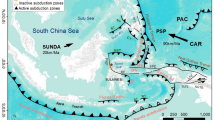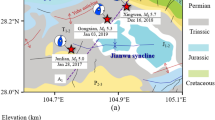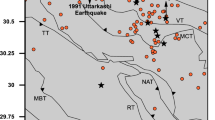Abstract
Multiple approaches are used to study the potential seismic hazard in the North China Craton (NCC, or North China Plain), where approximately 15 % of the Chinese population resides and under which active faults are located. In this study, we develop a new modified Mercalli intensity (MMI) attenuation relationship for the NCC using intensity data from 10 instrumentally recorded events. We then utilize this relationship to infer the magnitude and epicentral location of historic events based on the method proposed by Bakun and Wentworth (Bull Seismol Soc Am 87(6):1502–1521, 1997). In addition, a modified stochastic finite fault model is employed to simulate the strong ground motions caused by these historic events. The simulated peak ground accelerations and velocities are then converted into regional MMI distributions through empirical relationships, and these synthetic MMI maps are compared to field observations. The resultant MMI attenuation versus distance models of the 1976 M w 7.6 Tangshan event and the 1679 M 8.0 Sanhe-Pinggu event are consistent with the empirical attenuation relationships, and the location and size of the meizoseismal area (>VIII) are consistent with observations. The successful modeling of these historic events indicates that a stochastic finite fault model constrained by the regional MMI attenuation relationship can be used to evaluate a wide range of scenarios based on modern computational simulations. These findings may also provide useful information for the estimation and mitigation of potential seismic hazards in this region.





Similar content being viewed by others
References
Adrian MC, Nelson TK (2002) Intensity attenuation relationship for the South China region and comparison with the component attenuation model. J Asian Earth Sci 20:775–790
Atkinson GM, Boore DM (1995) Ground-motion relations for Eastern North America. Bull Seismol Soc Am 85:17–30
Atkinson GM, Boore DM (2006) Earthquake ground-motion prediction equations for Eastern North America. Bull Seismol Soc Am 96(6):2181–2205
Atkinson GM, Kaka SI (2007) Relationships between felt intensity and instrumental ground motion in the Central United States and California. Bull Seismol Soc Am 97(2):251–497
Atkinson GM, Sonley E (2000) Empirical relationships between modified Mercalli intensity and response spectra. Bull Seismol Soc Am 90(2):537–544
Atkinson GM, Wald DJ (2007) “Did You Feel It?” intensity data: a surprisingly good measure of earthquake ground motion. Seismol Res Lett 78(3):362–368
Bakun WH, McGarr A (2002) Differences in attenuation among the stable continental regions. Geophys Res Lett 29(23):1–36
Bakun WH, Scotti O (2006) Regional intensity attenuation models for France and the estimation of magnitude and location of historical earthquakes. Geophys J Int 164:596–610
Bakun WH, Wentworth CM (1997) Estimating earthquake location and magnitude from seismic intensity data. Bull Seismol Soc Am 87(6):1502–1521
Bakun WH, Johnston AC, Hopper MG (2003) Estimating locations and magnitudes of earthquakes in eastern North America from modified Mercalli intensities. Bull Seismol Soc Am 93(1):190–202
Boore DM (1983) Stochastic simulation of high-frequency ground motions based on seismological models of the radiated spectra. Bull Seismol Soc Am 73(6):1865–1894
Boore DM, Atkinson GM (2007) Boore-Atkinson NGA ground motion relation for the geometric mean horizontal component of peak and spectral ground motion parameters. Peer Report. Pacific earthquake engineering research center
Butler BR, Stewart GS, Kanamori H (1979) The July 27, 1976 Tangshan, China earthquake—a complex sequence of interpolate events. Bull Seismol Soc Am 69(1):207–220
Catalogue of Chinese Earthquake (CCE) (1983) Science Press, pp 105–109 (in Chinese)
Catalogue of Chinese Earthquake (CCE) (1999) China Science and Technology Press, pp 282–292 (in Chinese)
Dan K, Ishii T, Ebihara M (1993) Estimation of strong ground motions in meizoseismal region of the 1976 Tangshan, China, earthquake. Bull Seismol Soc Am 83(6):1756–1777
Day SM (1982) Three-dimensional finite difference simulation of fault dynamics: rectangular faults with fixed rupture velocity. Bull Seismol Soc Am 72:705–727
Du CX, Xie FR, Zhang Y, Shi BP (2010) 3D modeling of dynamic fault rupture and strong ground motion of the 1976 Ms 7.8 Tangshan earthquake. Chin J Geophys 53(2):290–304 (in Chinese)
Huang BS, Yeh YT (1997) The fault ruptures of the 1976 Tangshan earthquake sequence inferred from coseismic crustal deformation. Bull Seismol Soc Am 87(4):1046–1057
Huang WQ, Li WX, Cao XF (1994) Research on the completeness of earthquake data in the Chinese mainland (I)—North China. Acta Seismol Sin 16:273–280
Ishikawa Y, Zhu C, Cao T (1983) On some characteristics of strong aftershocks of the 1976 Tnagshan, 1975 Haicheng and 1976 Yanyuan-Ninglang earthquakes. Acta Seismol Sin 5:15–30 (in Chinese)
Johnston AC (1996a) Seismic moment assessment of earthquakes in stable continental regions—I. Instrumental seismicity. Geophys J Int 125:381–414
Johnston AC (1996b) Seismic moment assessment of earthquakes in stable continental regions—II. Historical seismicity. Geophys J Int 125(3):639–678
Johnston AC, Goldenstein G, Dockter ML, Moran NK, Metzger A (2010) A moment magnitude seismicity catalog for the United States East of the Rocky Mountain Front. Final Technical Report
Joyner WB, Boore DM (1993) Methods for regression analysis of strong-motion data. Bull Seismol Soc Am 83(2):469–487
Kikuchi M, Kanamori H (1986) Inversion of complex body waves—II. Phys Earth Plane Interiors 43:205–222
Liu HS (1979) Convection-generated stress concentration and seismogenic models of the Tangshan earthquake. Phys Earth Planet Inter 19:307–318
Liu M, Yang YQ (2005) Contrasting seismicity between the north China and south China blocks: kinematics and geodynamics. Geophys Res Lett 32:L12310
Liu BY, Shi BP, Zhang J (2007) Strong motion simulation by the composite source modeling: a case study of 1679 M8.0 Sanhe-Pinggu earthquake. Acta Seismol Sin 29(3):302–313 (in Chinese)
Molnar P, Deng Q (1984) Faulting associated with large earthquakes and the average rate of deformation in central and eastern Asia. J Geophys Res 89:6203–6227
Molnar P, Tapponnier P (1977) Relation of the tectonics of eastern China to the India-Eurasia collision: application of slip-line field theory to large-scale continental tectonics. Geology 5:212–216
Motazedian D, Atkinson GM (2005) Stochastic finite-fault model based on dynamic corner frequency. Bull Seismol Soc Am 95:995–1010
Nabelek J, Chen WP, Ye H (1987) The Tangshan earthquake sequence and its implications for the evolution of the North China basin. J Geophys Res 92:12615–12628
Nuttli O (1973) Seismic wave attenuation and magnitude relations for eastern North America. J Geophys Res 78:876–885
Shedlock KM, Baranowski J, Xiao W, Hu XL (1987) The Tangshan aftershock sequence. J Geophys Res 92:2791–2803
Singh SK, Bansal BK, Bhattacharya SN, Pacheco JF, Dattatrayam RS, Ordaz M, Suresh G, Kamal, Hongh, SE (2003) Estimation of ground motion for Bhuj (26 January 2001; M w7.6) and for future earthquakes in India. Bull Seismol Soc Am 93(1):353–370
Szeliga W, Hough S, Martin S, Bilham R (2010) Intensity, magnitude, location, attenuation in India for felt earthquakes since 1762. Bull Seismol Soc Am 100(2):570–584
Tapponnier P, Molnar P (1977) Active faulting and tectonics in China. J Geophys Res 82:2905–2930
Tsang HH, Sheikh MN, Lam NTK, Chandler AM, Lo SH (2010) Regional differences in attenuation modeling for Eastern China. J Asian Earth Sci 39:441–459
Wald DJ, Allen IT (2007) Topographic slope as a proxy for seismic site conditions and amplification. Bull Seismol Soc Am 97(5):1379–1395
Wald DJ, Quitoriano V, Heaton TH, Kanamori H (1999) Relationships between peak ground acceleration, peak ground velocity and Modified Mercalli Intensity in California. Earthq Spectra 15:557–564
Wells D, Coppersmith K (1994) New empirical relationships among magnitude, rupture length, rupture width, rupture area, and surface displacement. Bull Seismol Soc Am 84:974–1002
Worden CB, Gerstenberger MC, Rhoades DA, Wald DJ (2012) Probabilistic relationships between ground-motion parameters and Modified Mercalli Intensity in California. Bull Seismol Soc Am 102(1):204–221
Xie X, Yao Z (1991) The faulting process of Tangshan earthquake inverted simultaneously from the teleseismic waveforms and geodesic deformation data. Phys Earth Planet In 66:265–277
Yin A, Nie S (1996) A Phanerozoic palinspastic reconstruction of China and its neighboring regions. In: Yin A, Harrison TM (eds) The Tectonic evolution of Asia. Cambridge University Press, Cambridge, pp 442–485
Zhang ZM, Liou JG, Coleman RG (1984) An outline of the plate tectonics of China. Geol Soc of Am Bull 95:295–312
Zhao LF, Xie XB, Wang WM, Zhang JH, Yao ZY (2010) Seismic Lg-wave Q tomography in and around Northeast China. J Geophys Res 115:B08307
Acknowledgments
We thank the anonymous reviewers who provided interesting suggestions and help to improve the quality of the manuscript. This research was supported by the CAS/SAFEA International Partnership Program for Creative Research Teams (KZZD-EW-TZ-19).
Author information
Authors and Affiliations
Corresponding author
Appendix
Appendix
1.1 Methods
We use the method of Bakun and Wentworth (1997) to analyze the intensities assignments using a previously derived attenuation relationship. For each earthquake, we calculate the intensity magnitude, M I, and the rms[M I] over a grid of trial epicenter locations. The following attenuation relationships are used in this study to determine the historical earthquake magnitudes and locations:
where Ini and Δ i are the intensity value and the distance (km) between the intensity (MMI) observation location and the epicenter at site i, respectively, M i is the magnitude estimated from Eq. (2), and M I is the mean magnitude at the trial epicenter. The rms is defined as follows:
where \({\text{rms}}_{0} (M_{I} - M_{i} )\) is the minimum \({\text{rms}}(M_{I} - M_{i} )\) over the grid of trial epicenters and W i is Bakun and Wentwoth’s (1997) distance weighting function, defined as follows:
where a is the “water level” and b is the cutoff distance in km. Bakun and Wentworth (1997) noted that the “water level” and cutoff distance chosen for the weighting function are arbitrary. However, our calculation indicates that if the b value is above 400 km, a better closure of rms[M I] contours is obtained. The contours of rms[M I] bound the epicentral region and are associated with different levels of confidence of the epicenter location. M I values at tectonically active trial epicenters within the appropriate confidence level contours give the best estimates of magnitude for those epicenters.
1.2 Case studies
The strategy suggested above was tested for two pre-1900 earthquakes, the 1668 Tancheng earthquake and the 1679 Sanhe-Pinggu earthquake, and two instrumental earthquakes, the 1966 Longyao earthquake and the 1969 Bohai earthquake.
1.2.1 The 1668 Tancheng earthquake
This earthquake occurred on 25 July 1668 and is generally considered the largest recorded earthquake in China. The magnitude is estimated to be 8.5, and the estimated epicenter is 35.3°N and 118.6°E. We chose 118 intensity values to bound the epicentral region and to calculate the magnitude. Figure 6 shows a map of the rms[M I] and M I (b = 480 km). In Fig. 6, the innermost, middle, and outermost contours of rms[M I] correspond to the 50, 80, and 95 % confidence levels for the location, respectively, and M I is 8.8.
Map of contours of rms[M I] as colored areas and M I as dashed lines for 1668 Tancheng earthquake. Total number of intensity assignment sites we used is 118, and round dots are part of them. The triangle is the estimated epicenter (118.6°E, 35.3°N), located within the 50 % confidence region, where M I is 8.8
1.2.2 The 1679 Sanhe-Pinggu earthquake
This earthquake occurred on 2 September 1679; the intensity value was XI in the meizoseismal area. The magnitude is estimated to be 8.0, and the estimated epicenter is 40.0°N and 117.0°E, as reported by another study. Figure 7 shows a map of the rms[M I] and M I (b = 1,000 km). The estimated epicenter (117.0°E, 40.0°N) is located within the 90 % confidence region, where M I is 7.8.
Map of contours of rms[M I] as colored areas and M I as dashed lines for 1679 Sanhe-Pinggu earthquake. Total number of intensity assignment sites we used is 225, and round dots are part of them. The triangle is the estimated epicenter (117.0°E, 40.0°N), located within the 90 % confidence region, where M I is 7.8
1.2.3 The 1966 Longyao earthquake
This earthquake occurred on 8 March 1966. The surface magnitude was 6.8, and the instrumental epicenter was 37.4°N and 114.9°E. Figure 8 shows a map of the rms[M I] and M I (b = 480 km). The epicenter is located within the 67 % confidence region, where M I is 7.1.
Map of contours of rms[M I] as colored areas and M I as dashed lines for 1966 Longyao earthquake. Total number of intensity assignments sites we used is 130, and round dots are part of them. The triangle is the instrumental epicenter (114.9°E, 37.4°N), located within the 67 % confidence region, where M I is 7.1
1.2.4 The 1969 Bohai earthquake
This earthquake occurred on 18 July 1969. The instrument-observed magnitude was 7.4, and the instrumental epicenter was 38.2°N and 119.4°E, inside the Bohai Sea; the intensity value of the meizoseismal area is unknown. Figure 9 shows a map of the rms[M I] and M I (b = 400 km). The epicenter is located within the 80 % confidence region, where M I is 6.9.
Map of contours of rms[M I] as colored areas and M I as dashed lines for 1969 Bohai earthquake. Total number of intensity assignments sites we used is 125, and round dots are part of them. The triangle is the instrumental epicenter (119.4°E, 38.2°N), located within the 90 % confidence region, where M I is 6.9
Rights and permissions
About this article
Cite this article
Shen, W., Zhong, Q. & Shi, B. Synthetic seismic intensity for historic earthquakes in the North China Plain: implications for the regional seismic hazard. Nat Hazards 74, 305–323 (2014). https://doi.org/10.1007/s11069-014-1195-3
Received:
Accepted:
Published:
Issue Date:
DOI: https://doi.org/10.1007/s11069-014-1195-3








